Expert’s Rating
Pros
- Two-day battery life
- Dazzling 120Hz screen
- Slim and sleek build
- Great value
Cons
- Mixed camera performance
- Cluttered MIUI OS
- Poor speaker
Our Verdict
There’s no denying that the Poco X5 offers a lot for the money, but you can get similar specs for less with a phone from the previous generation.
Price When Reviewed
Not available in the US
Best Prices Today: Poco X5
Poco’s 2023 X-range phones are here, and the cheaper of the pair is the Poco X5. Launched alongside the Poco X5 Pro, this phone comes complete with a dazzling 120Hz AMOLED display (a first from a base X-range Poco phone), fast-charging technology and a 48Mp triple camera set-up.
But is the phone still good value for money, especially considering its place in the highly competitive mid-range space? I’ve spent some time with the Poco X5 to see how it handles everyday use.
Design & build
- Three colour options
- IP53 rating
- 3.5mm headphone jack
The Poco X5 comes with an understated yet sleek finish – a welcome relief from the days when Poco used to blaze its logo on the entire back. The phone is 7.98mm thick, and weighs just 189g, so it’s relatively slim and lightweight and doesn’t feel heavy to hold.
The slightly metallic finish catches the light well, but it is prone to picking up fingerprints
It comes in either blue, green or black, which I tested. The device is made from plastic with a Gorilla Glass 3 front, which doesn’t exactly scream high-end. The slightly metallic finish catches the light well, but it is prone to picking up fingerprints and smudges throughout the day.
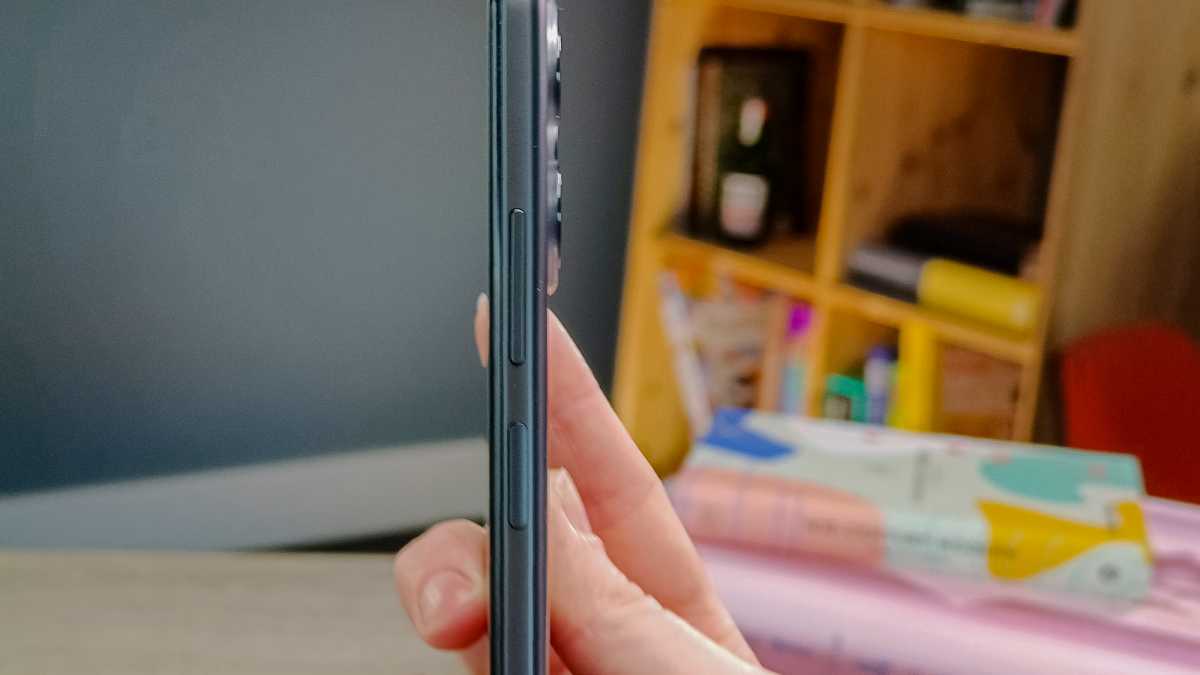
Hannah Cowton / Foundry
On the plus side, it is less susceptible to scratches or damage than a phone with a glass rear. Plus, it comes with an IP53 rating, which means it also protected from some dust and light rain – but it is not waterproof. Poco throws in a free clear case in the box for extra protection.
The Poco logo is still present, just tucked away more neatly adjacent to the camera bump, which produces quite largely out the back. This does mean that the phone doesn’t lay fully flat on a desk.
The Poco X5 has a USB-C port for charging, a 3.5mm headphone jack, as well as dual-SIM slot, which can either be used for two SIMs, or one SIM and a Micro-SD card. The phone uses a side-mounted fingerprint scanner on the power button, which I found to be largely reliable.
Screen & speakers
- 6.67in FHD AMOLED display
- 120Hz refresh rate
- Poor speaker
The phone comes with a dazzling 6.67in FHD AMOLED display, protected by Corning Gorilla Glass 3. It comes with DCI-P3 wide color gamut, and a claimed peak brightness of 1200 nits.
Many other mid-rangers sacrifice a high refresh rate, so this is a big plus for the Poco X5
Colours are vivid and bright on the Poco X5, meaning it’s great for streaming videos and browsing through images. It certainly doesn’t feel like a lower mid-range phone in this regard. Poco also offers an adjustable colour temperature option on the display to suit your preferences.
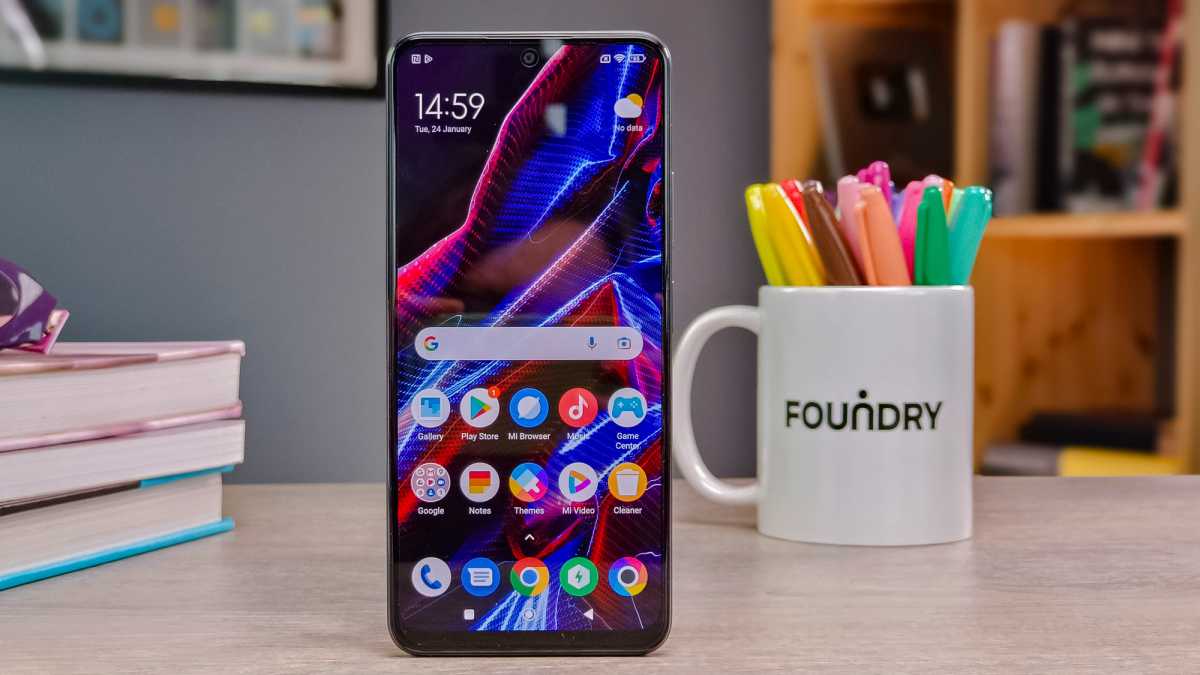
Hannah Cowton / Foundry
There is a refresh rate of up to 120Hz, but you can also opt for 60Hz if you’re looking to conserve the battery life. This is combined with a touch-sampling rate of up to 240Hz.
This results in quick and responsive navigation, both when scrolling social media and doing some light gaming. Many other mid-rangers sacrifice a high refresh rate, so this is a big plus for the Poco X5.
There is one single speaker located on the bottom of the phone, which means that sound is on the weak and tinny side. The lack of audio processing software means that music lacks bass and depth – though on a phone of this price point, premium audio is a luxury.
Specs & performance
- Snapdragon 695
- 6/8GB RAM
- 128/256GB storage
The Poco X5 runs on a Snapdragon 695 chip, the same processor seen on the Poco X4 Pro. You can pair this with either 6GB RAM and 128GB storage, or 8GB RAM and 256GB worth of storage. The additional microSD slot can extend internal storage up to 1TB.
Overall, this phone has capable performance. I used it for social media, YouTube, Twitch and general browsing, and it handled everything largely well. However, some apps do have the odd stutter here and there. For example, videos on Facebook often take time to load, and rebooting the device often results in some slow starts.
The phone achieved similar performance scores to the likes of the Realme 9 and the OnePlus CE 2 Lite:
Like other Poco X devices, it is capable of some gaming, but don’t be expecting the highest levels of performance. I was able to play Genshin Impact on the second-lowest graphics settings, but even then I experienced some lag and low frame rates. More casual titles such as Animal Crossing Pocket Camp worked just fine.
5G connectivity comes included, as does Bluetooth 5.1.
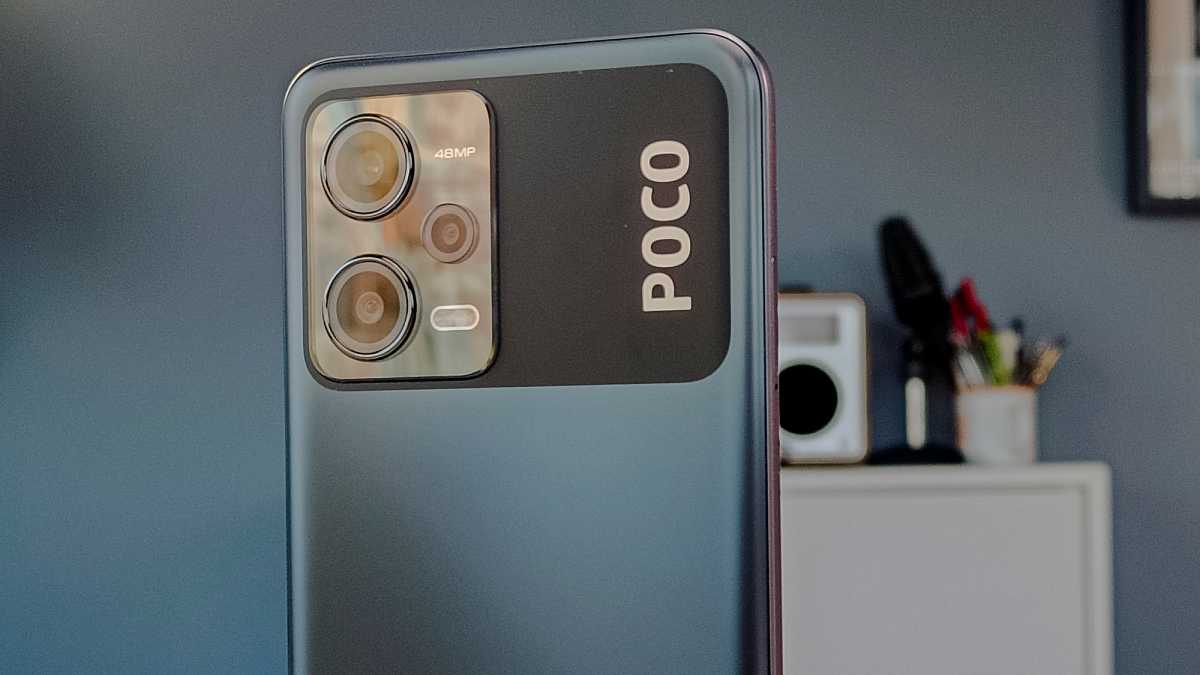
Hannah Cowton / Foundry
Battery life & charging
- 33W fast charging
- 5000mAh battery
- No wireless charging
In the box you get a 33W fast charger. This will take you from zero to 58% in just 30 minutes, with full charging taking around an hour.
By today’s standards, this isn’t the quickest – phones from the likes of Realme and Oppo certainly offer speedier charging bricks.
Whatever the X5 lacks in super speedy charging is made up for with that big 5000mAh battery. Even when running the refresh rate on 120Hz, I was able to use it for roughly around two days, snapping pics, doom-scrolling on Twitter and watching livestreams.
In our usual PCMark battery test, the phone managed a middling 10 hours and two minutes.
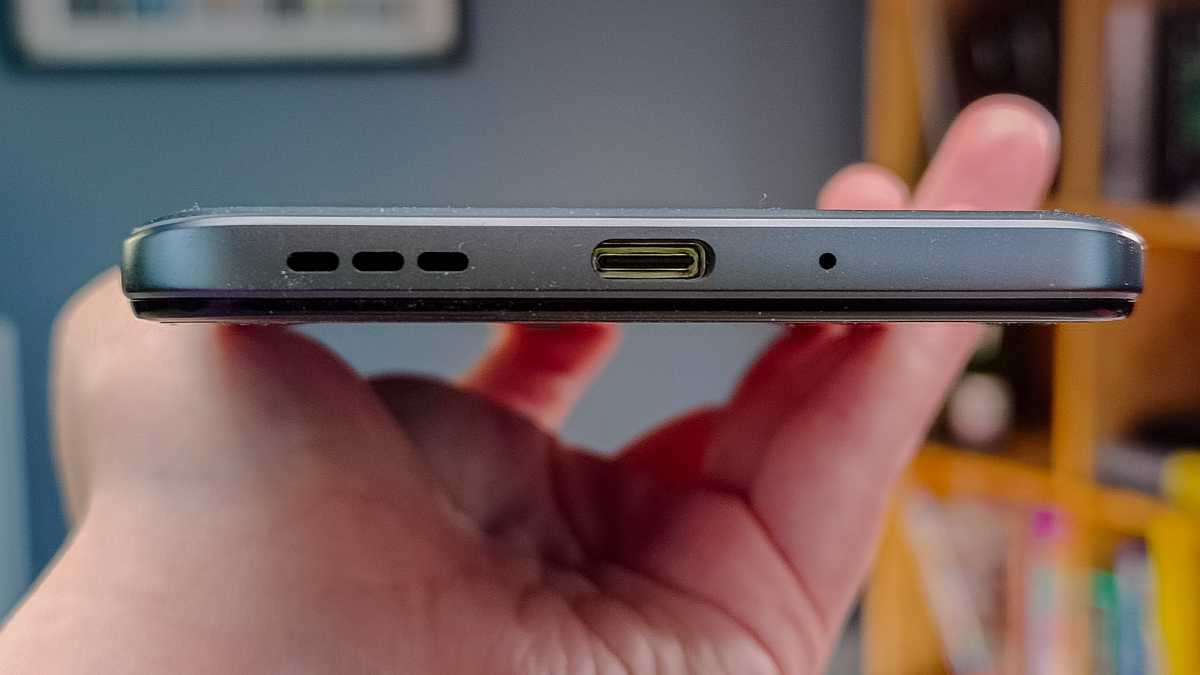
Hannah Cowton / Foundry
If you make use of the battery saving modes, and generally are a little more conservative with usage, then you could stretch the Poco X5 even further.
There isn’t any wireless or reverse charging included on the phone, but that is typical for a phone of this price.
Cameras & video
- Decent main 48Mp main camera in good lighting
- Unimpressive in low light
- So-so secondary lenses
The Poco X5 comes with a triple rear snapper, led by a 48Mp main camera with an f/1.8 aperture. This is joined by the secondary lenses, an 8Mp wide-angle with a 118-degree field of view, as well as a 2Mp macro lens with an f/2.4 aperture.
The X5 can produce sharp and detailed images on shots taken outdoors with good lighting conditions. Colours do not look oversaturated or washed out, as you may find on other devices of a similar price.
Like other Xiaomi phones, the Poco X5 uses pixel-binning technology. Snaps do look good both when using the full 48Mp resolution camera, and when taking photos on the standard mode which are condensed down to a 12Mp output.
The same cannot be said for lower light conditions. Textures become much fuzzier and blended, and it’s hard to focus on the subject that you’re pointing at. Night mode adds some colour, but the final image looks like a faded vintage photo (and not in a good way).
The zoom capabilities are also unimpressive on this phone. Whilst details are still clear on X2 zoom, colours on the grass and sky in the test shots appear much more insipid. Zooming in even further results in extremely blurry images.
The X5 can produce sharp and detailed images
Things are even less sharp on the 8Mp wide-angle lens, which performs even worse under low light. However, for large landscape shots during the day, it is sufficient.
Accessing the 2Mp macro camera is a bit of a challenge in the MIUI interface, but I wouldn’t advise going hunting for it. Whilst you can get close-up shots, it’s hard to focus and shades are very dull.
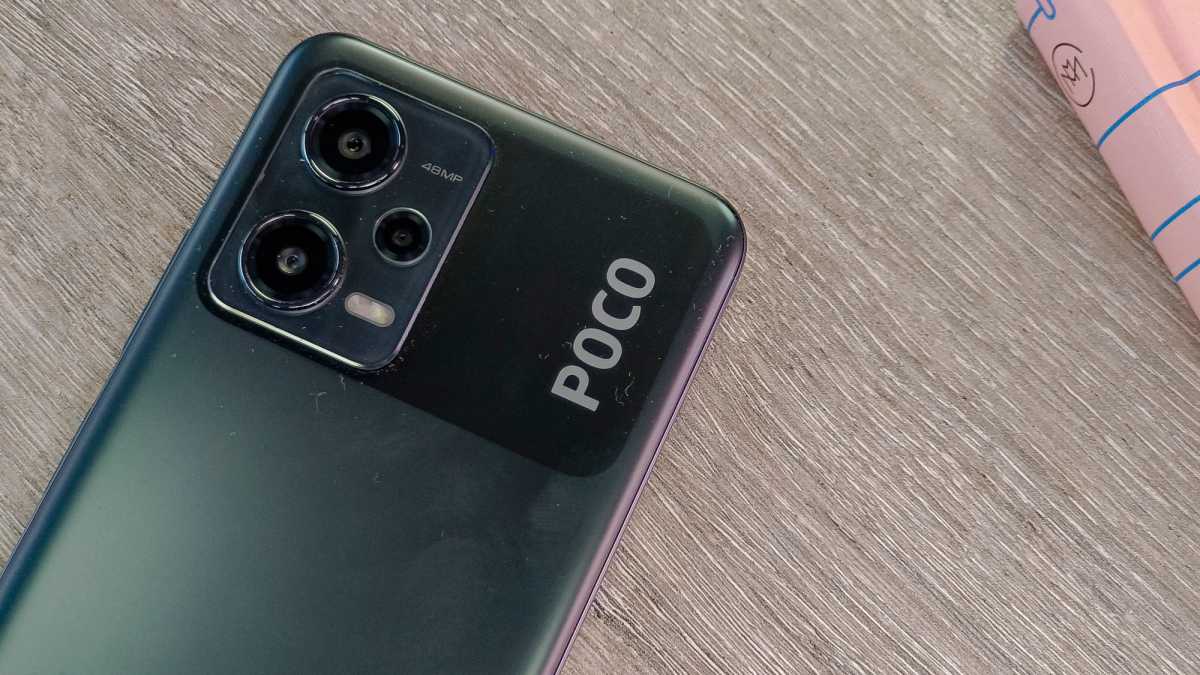
Hannah Cowton / Foundry
On the front, there’s a 13Mp snapper with an f/2.45 aperture. Like the rear cameras, performance isn’t too bad outdoors or with good lighting. However, dimmer conditions result in poorer textures and muted colours. The bokeh effect on portrait mode also struggles with hair textures, particularly waves and curls.
In addition, Poco automatically adds a slight ‘beautify’ filter to selfies, which can be turned off or made stronger. In short, this erases facial blemishes such as freckles, and makes it look as if you have make-up on.
This shouldn’t be enabled as standard. Not only does it give a slightly false finish, but it also plays into unrealistic beauty standards set by Instagram filters. Poco should consider having this feature optional on future phones.
Video is available either in 720p at 60fps, or 1080p at 30fps. However, there is no auto stabilisation software present, so beware if you have shaky hands.
Software & updates
- MIUI 13
- Confusing navigation
- App bloat
The Poco X4 comes running on MIUI 13.0.2, Xiaomi’s skin of Android 12. This isn’t the latest Android version, but many mid-range phones still run on this OS at the time of writing. Oddly, you can get MIUI 14 on the X5 Pro, although changes are largely minimal.
Xiaomi’s MIUI is an acquired taste, and if you’re a pure Android enthusiast like me, then you may find the changes jarring. The drop-down menu is split into two halves, like on iOS. If you swipe down from the left-hand side, you’ll get your notifications, whilst on the right you’ll access the quick settings.
General navigation can be a bit confusing. For example, on the camera app the macro mode is hidden away the section where you crop photos, rather than in the ‘more’ section like it is on other devices.
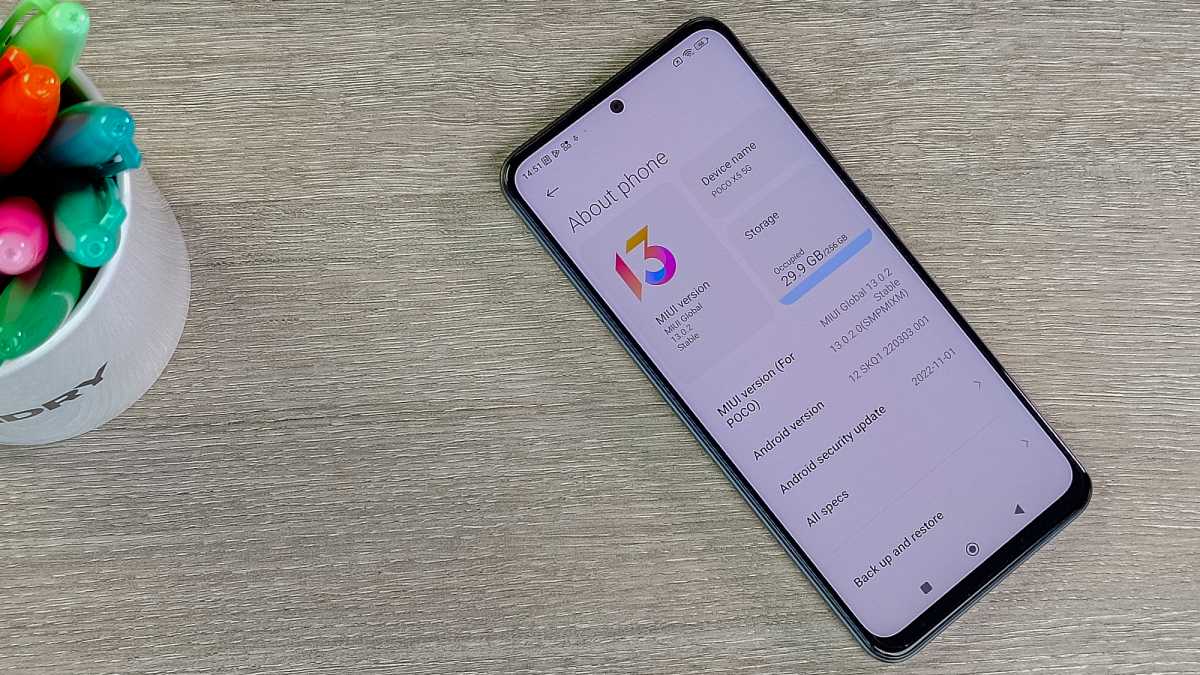
Hannah Cowton / Foundry
On the plus side, you can multitask on the phone with floating windows and set up two separate profiles on the device through Second Space. There is also a dedicated Game Space mode which will close background apps when playing a title to help improve performance.
The biggest annoyance of a Poco phone is the amount of pre-loaded apps cluttering up the interface. From a very pointless Poco store app, to Aliexpress and strange games such as Tile Fun, you’ll likely be taken aback by the number of things on the phone as soon as you launch it out of the box.
At the time of writing, we don’t yet know how many years of security and software updates are promised for the Poco X5.
Price & availability
The Poco X5 is available to buy now from the Poco website, priced at £279/€299 for the 6/128GB version, and £319/€349 for the 12/256GB one. If you buy it before the 13 February 2023, you can grab £30 off the standard price.
Typically, Poco doesn’t sell its phones in the US, but American readers should be able to import it from the likes of AliExpress.
There’s no denying that once again, Poco has produced an affordable phone for the price, with a solid build, a big battery life, an impressive display and a decent main camera in daylight.
That said, the processor is the same one offered in the Poco X4 Pro, which also comes with a higher-spec camera and faster charging. More importantly, the RRP of this phone is cheaper than the X5. Therefore, you’ll get more bang for your buck with the Pro version of the previous generation.
Alternatively, you could step up to the more mid-range Poco X5 Pro, which comes with an upgraded processor, double the charging speeds and a better camera that produces much clearer shots in low light. However, this clocks in nearly £100/€100 more than the X5.
You can look at other options in our chart of the best mid-range phones.

Hannah Cowton / Foundry
Verdict
The Poco X5 is truly an excellent mid-range buy.
The 120Hz display is great to use for videos and social media, and the 5000mAh battery will give you two days’ worth of use with ease.
There are always sacrifices for phones at this price point, and the X5 makes them with its poor low-light photography and unimpressive speaker. The MIUI OS is also not the most user-friendly, especially with the amount of bloatware.
The biggest downfall is that the Poco X4 Pro still trumps this phone in terms of value for money. Nonetheless, you’ll still be getting bang for your buck with the Poco X5 if you want the latest model.
Poco X5 specs
- Android 12, MIUI 13
- 6.67in AMOLED display (120Hz, FHD+)
- Snapdragon 695 with 6GB/8GB RAM
- 128/256GB storage, expandable by 1TB via microSD
- 5G
- Bluetooth 5.1
- Wi-Fi 5
- 48Mp f/1.8 main rear camera
- 8Mp 118-degree ultra-wide camera
- 2Mp f/2.4 macro lens
- 13Mp f/2.45 selfie camera
- Fingerprint reader in power button
- 3.5mm headphone jack
- 5000mAh battery
- 33W fast charge tech
- Gorilla Glass 3 (front)
- Plastic body
- 165.88 x 76.21 x 7.98mm
- 189g
- Available in Black, Blue and Green
